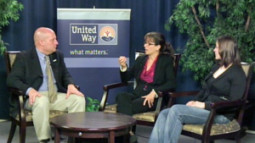Click here to view and download the full press release PDF
PRESS RELEASE
FOR IMMEDIATE RELEASE
June 27, 2013
Flow Featured on UpNorth TV’s Volunteer Northwest Michigan Program in July
 TRAVERSE CITY, MI – FLOW, the Great Lakes Basin’s only public trust policy and education center, will be featured on UpNorth TV, channel 2, throughout the month of July, every Sunday and Wednesday evening from 8pm-9pm, and every Friday morning from 9am-10am. Hosted by United Way of Northwest Michigan, the Volunteer Northwest Michigan show highlights FLOW’s innovative programs to ensure the waters of the Great Lakes are protected now and for future generations. UpNorth TV’s feature on FLOW will also be available online.
TRAVERSE CITY, MI – FLOW, the Great Lakes Basin’s only public trust policy and education center, will be featured on UpNorth TV, channel 2, throughout the month of July, every Sunday and Wednesday evening from 8pm-9pm, and every Friday morning from 9am-10am. Hosted by United Way of Northwest Michigan, the Volunteer Northwest Michigan show highlights FLOW’s innovative programs to ensure the waters of the Great Lakes are protected now and for future generations. UpNorth TV’s feature on FLOW will also be available online.
Steven Wade, United Way’s Executive Director of Northwest Michigan, interviews FLOW’s Chair and President, Jim Olson, Executive Director, Liz Kirkwood, and Communications Designer, Allison Voglesong, about how locals can volunteer with FLOW and take part in protecting our beloved Great Lakes.
FLOW has several upcoming volunteer opportunities. On July 5th, FLOW will participate in DTE Energy’s Green Day during Cherry Festival. Volunteers will assist members of the FLOW staff educate the community about threats to the Great Lakes with a fun and interactive game. Additionally, volunteer positions are available for Blissfest on July 12, 13, and 14; Friday Night Live on August 9; and our Annual Celebration on August 17. Sign up here to volunteer.
Additionally, this TV segment discusses FLOW’s programs, including the public trust education program, water levels program, local government “fracking” ordinance program, and water-energy-food-climate change nexus program. Additionally, Jim Olson, environmental attorney, who has been practicing environmental and water law for more than 40 years, gives an in depth history of water law in Michigan and tells the story of how FLOW evolved from a coalition to a policy and education center.
FLOW’s approach to policy and education for preserving and protecting the Great Lakes centers on the ancient principle of the public trust. The public trust is a key principle that enables citizens and governments to protect our waters as a commons, owned and shared by the public for the use and enjoyment of all. The public trust doctrine is the legal foundation for protecting and maintaining resources such as beaches, navigable waterways and harbors, wetlands and wildlife, tributary streams, and groundwater. Additionally, it protects public uses including navigation, commerce, fishing, boating, swimming, other recreational purposes, and drinking water.
Fishers, boaters, swimmers, beach-goers, and other water-lovers of all ages should tune in to UpNorth TV in July to learn more about how they can work with FLOW to ensure that the Great Lakes are protected for our favorite activities now and for future generations.
The segment will air on Charter Cable’s analog channel, 97, and digital channels, 2 and 992, throughout Northwestern Lower Michigan from Manistee to Cheboygan.
# # #
FLOW is the Great Lakes Basin’s only 501(c)(3) nonprofit public trust policy and education center. Our mission is to deeply educate communities and leaders about the public trust as a solution for sharing and preserving our common waters.

